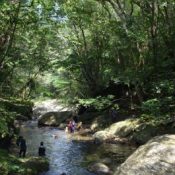
October 11, 2019 Ryukyu Shimpo
By Yoko Tabuki
Imagine a highland with spectacular views of lush green forests and the great Pacific Ocean, where during the day, the Okinawa rail and the Okinawa woodpecker can be heard, while at night, stars fill the sky. That’s Takae in a nutshell. Takae is a small town with a population of 100, located at the edge of Higashi Village, in the nature-rich northern region of Okinawa’s main island. Many of its residents make a living off of pineapple farming, making Takae the top pineapple producer in Japan. October 11 marked two years to the day since a CH-53E heavy-lift helicopter, based at U.S. Marine Corps Air Station Futenma, made an emergency crash-landing in the tranquil district of Takae before bursting into flames. How did a U.S. military helicopter end up in this neighborhood enclosed in nature? Takae’s embroilment in the U.S. military base issues in Okinawa does not stop with this incident. We look back on the twelve years of distress experienced by Takae residents, including episodes pertaining to the construction of helipads, through past articles and photos.
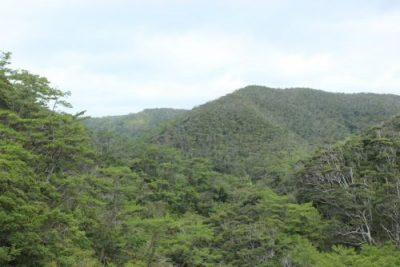
The lush green landscape of Yanbaru, Higashi Village, photographed in 2013.
The CH-53E helicopter made an emergency landing in a pasture just 200 meters from a private residence in Takae. The pasture and the adjacent home belonged to Akira Nishime, 66. At the time, his wife, Mieko, told the Ryukyu Shimpo during an interview: “We could have died.” It was a miracle that no one was out in the pastures, which was nearing hay harvest.
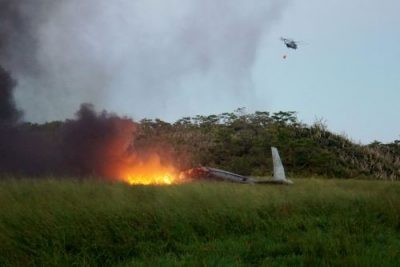
The Futenma-based CH-53E heavy-lift helicopter burst into flames after crash-landing in a pasture on October 11, 2017 in Takae, Higashi Village. The aircraft pictured in the sky is attacking the fire with buckets of water from above.
A community surrounded by U.S. military bases
Takae is encircled by U.S. military bases. The forests surrounding the district itself is used as training grounds by the military.
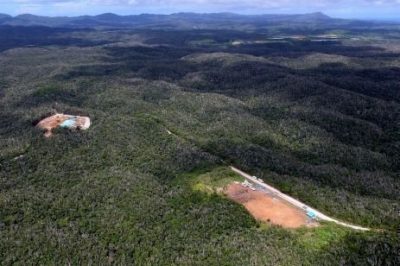
The Northern Training Area (NTA), also known as the Jungle Warfare Training Center (JWTC) photographed by a drone in October 2016 in Higashi.
The U.S. military converted 7,543 hectares of land into the Northern Training Area (NTA) after acquiring Okinawan lands in 1957. According to the prefecture’s website, the NTA enables guerilla training, and as of 2019, contains 21 helicopter landing zones within it. During the Vietnam War, the U.S. military created a “Little Vietnam” in the NTA, and in some cases made Takae locals play Vietnamese roles. Witness testimonies indicate that defoliants, including highly toxic dioxins, were used in these forests.
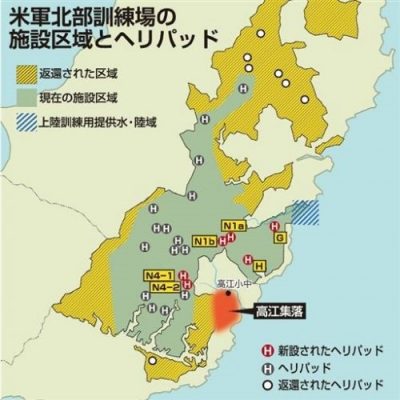
In December of 1996, the Special Action Committee on Okinawa (SACO) agreement established that 3,987 hectares of land, a majority of the NTA, would be returned to Okinawa. However, one condition of the agreement involved relocating six helicopter landing zones from Kunigami, which was to be returned to Okinawa, to Takae district. Like the relocation of Futenma base to Henoko, Nago City, the decision to relocate a U.S. military facility within the prefecture was forced onto the local residents.
The Japanese government sues the citizens of Takae
Takae locals strongly opposed building new helipads for its relocation. Numerous resolutions were passed to demand the construction plans be withdrawn. However, one early morning in July 2007, the Okinawa Defense Bureau commenced construction work. Takae residents staged a sit-in to stop the heavy trucks from bringing in construction materials.

Security personnel proceed to open the gates at Takae around 8:02 a.m. on July 3, 2007, even as the locals stage a sit-in at the site.
In 2008, the Ministry of Defense and the Okinawa Defense Bureau filed a provisional injunction at the Naha District Court to restrain 15 Takae residents, including an 8-year-old (the child was later dropped from the injunction) from blocking traffic at the site. Many experts criticized this “strategic lawsuit against public participation” (also known as “SLAPP”) for impeding on the freedom of expression. The suit escalated into a court case, which resulted in a total defeat for Takae locals, when the Supreme Court decided to reject their appeal.
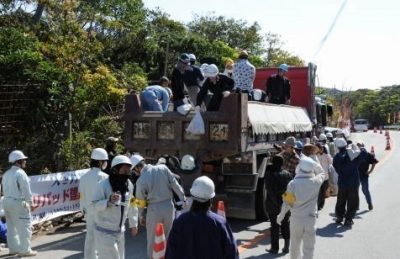
Tensions arise as protestors surround a dump truck in an attempt to obstruct the construction work of the helipad in Takae, Higashi Village. Photographed around 2 p.m. on February 2, 2011.
The government forced through construction work while residents continued to stage sit-ins day and night. Construction of two helipads in the Southside (the N4 area) was completed by 2014. After 2016, construction of four helipads in the Northside (two sites in N1, one each in Gt and H areas) resumed.
Construction work resumes
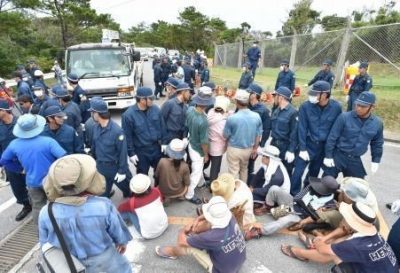
The riot police remove locals protesting the delivery of construction materials. Photographed at the NTA main gates in Takae, Higashi Village, at around 1:22 p.m. on July 11, 2016.
Construction work at the helipad site resumed the morning after the Upper House elections, on July 11, 2016. Just past 6 a.m., the government deployed 100 riot police and 20 private guards. The stare down between the two sides began after 60 locals from within and without Takae district rushed to the gate. As this conflict intensified over the next five months, numerous incidents erupted—Several locals were arrested, riot police physically encircled some reporters, blocking their newsgathering, and made discriminatory comments against Takae residents.
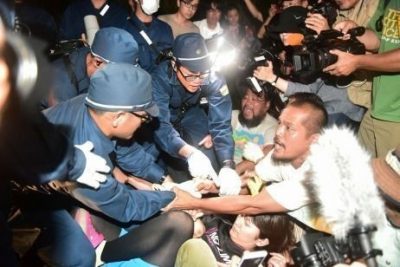
Riot police removing the protesting locals at Takae, Higashi Village, at 10:54 p.m. on July 21, 2016.
Even so, the government resumed construction work, and all six helipads were completed by December 2016. Subsequently, 4,010 hectares of the NTA was returned to Japan. The Japanese government emphasized how this reduced the burden placed upon Okinawa as a military host. Simultaneously, the government planned to add the returned land to the Yambaru National Park and re-nominate the area for UNESCO’s World Natural Heritage Site.
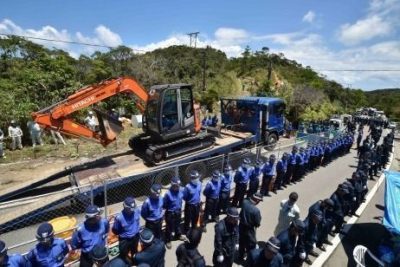
The Okinawa Defense Bureau resuming construction of a helipad around 1:30 p.m. in Takae, Higashi Village, on July 22, 2016.
Then the helicopter came down
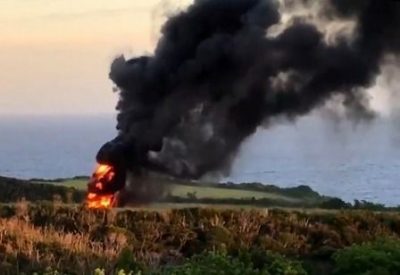
A Futenma-based CH-53 heavy-lift helicopter burst in flames after making a crash-landing in a pasture in Takae, Higashi Village, after 6 p.m. on October 11, 2017. (Photograph provided by a Ryukyu Shimpo reader.)
When the heavy-lift helicopter was forced to land in a pasture located in the Kuruma neighborhood of Takae around 5:20 p.m. on October 11, 2017, the construction of the six helipads in Takae district was completed, and two of the helipads in the Southside were already operational. The CH-53 was wrecked, but there were no injuries to the residents or crew.
The scene of the accident was soon illuminated and flooded with flashing red lights, as fire trucks and police cars drove in and out. The town was thrown into confusion as the smell of burning fuel filled the air.
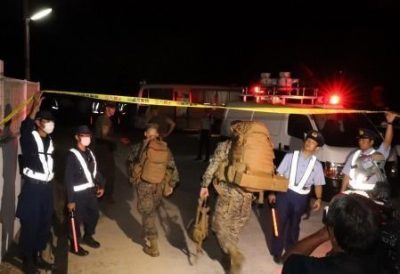
The pasture belonged to Akira Nishime and his family, who lived nearby. When the accident occurred, Nishime’s wife, Mieko, was mowing the lawn around their home. Mieko climbed on to a tank in the garden and saw black smoke rising from the pasture after her father-in-law, Kiyoshi, called out to her. Kiyoshi was inside a pig pen located just 100 meters from where the helicopter landed.
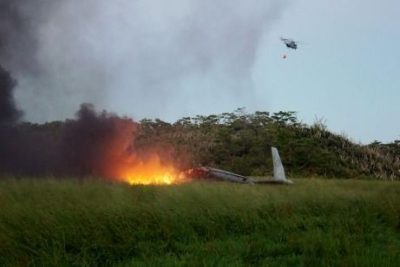
Flames engulf the CH-53E after it made an emergency-landing in a pasture in Takae, Higashi Village, around 6:15 p.m. October 11, 2017.
The Nishime family makes a living farming grass hay for cows and goats. Peak harvest was fast approaching at the time of the accident. Subsequently, the Okinawa Defense Bureau decided to compensate the Nishimes until the crop quality recovered to normal levels, but the compensation promised by the government was never paid out to the family. Nishime is worried: “It’s been radio silence. It’s like the government forgot about us.” He revealed that U.S. military aircrafts “still fly over private fields and residences, as if nothing ever happened. Not a thing has changed in the past two years.”
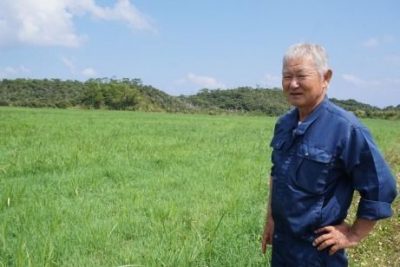
On October 8, 2019, Akira Nishime stands in the same pasture in Takae, where the helicopter crash-landed two years prior. He is uncertain he will ever receive the promised compensation.
The U.S. military took soil from the scene, just as it had in 2004, when one of its helicopters crashed on the Okinawa International University campus. Some of the soil was disposed of outside Okinawa, without notifying the Japanese government. Backlash from Okinawans mounted, as evidence critical to the investigation of this accident was lost.
Life goes on
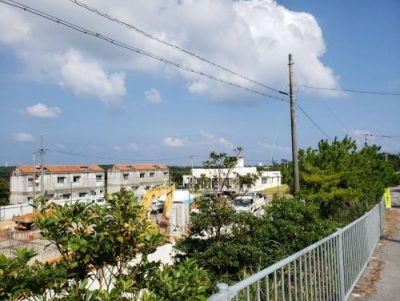
The neighborhood of Takae photographed on October 8, 2019.
Few reporters and non-villagers come to Takae now, compared to a couple years ago, when large-scale protests had erupted over the CH-53E accident combined with the Takae helipad construction. At a glance, it seems as though Takae residents have returned to living a tranquil life. However, since February 2015, when helipads were provided to the U.S. military in the N4 area on the Southside, sound pollution levels have been intensifying. During 2014, the Defense Bureau recorded 1,280 instances in which noise levels exceeded 60 decibels (7 a.m. – 7p.m.) on a cow path, whereas in 2015, after the helipads were provided, the number tripled to 3,686 instances. FY 2018 marked a record high, at 5,327 instances. Military aircrafts fly in the dead of the night, which continues to disrupt the residents from getting a quiet night’s sleep.
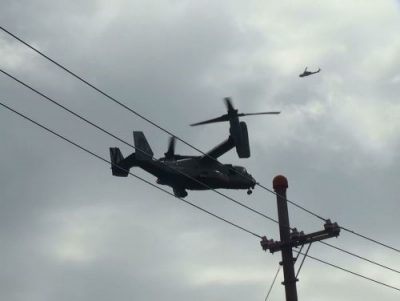
A U.S. military Osprey and helicopter both training above Highway 70, at 12:09 p.m. on January 1, 2017, near the NTA N4 area in Takae, Higashi Village. (Photograph provided by Akino Miyagi)
Just in September this year, the U.S. military mistakenly landed a helicopter 11 kilometers away from Takae, in the neighboring village of Yasuda, Kunigami—an area which was returned to Japan from the U.S. The Japanese government stressed that the return of NTA land from the U.S. has reduced the burden on Okinawa, but in reality, the locals are placed in constant danger.
During the month of September, Takae residents were busy preparing for a harvest festival for the first time in ages. The locals gathered every day to rehearse, as if to make up for the previous festival, which was cancelled due to the confusion surrounding the helipad construction. The population of Takae has aged, and shrunk by 50, in the past six years. Kumiko Nakamine, 69, district leader of Takae, watched over the dance practice for the classic Okinawan number, Kagiyade-fuu, and said in a low voice, “Kagiyade-fuu is typically danced by a pair of middle-school students, but currently, there is only one middle-school student in Takae. So, the other part went to an elementary-school student.”
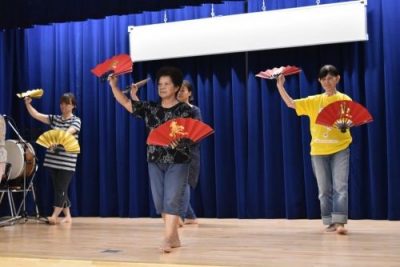
In preparation for the first harvest festival in six years, the locals practice at the Takae Community Center located in Higashi Village on September 9, 2019.
Regardless of its small population, Takae’s harvest festival was a success, as both long-time Takae residents and recent transplants new to Okinawa, came together.
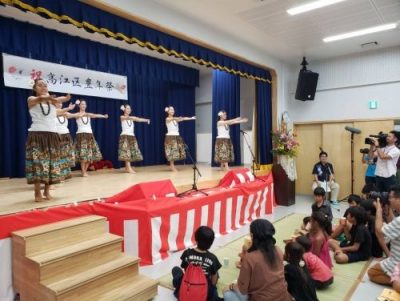
The harvest festival photographed on September. 13, 2019, at the Takae Community Center in Higashi Village.
The highlight of the festival was the “Pine-taro,” an original play put on by the young men’s association. The play’s main character “Pine-taro,” along with other characters, including an Okinawa rail and a boar, stop the antagonist contractor, wishing to destroy Takae’s nature in the name of development. In the final scene, the town proposes an economic development plan, which utilizes its abundant nature, and all the characters become friends in a happy ending.
Yoshi Nishime, 90, born and raised in Takae, summed up the event in two words: “The best.”
Takae resident, Takashi Ishihara, 49, remembered the distress Takao residents endured over the years and said, “A lot has happened [in Takae],” then emphasized that, “even so, we will again assure each other of our connectedness.”
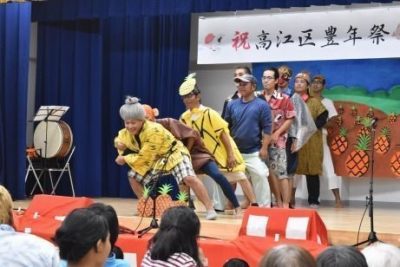
The young men’s association takes the stage at the harvest festival on September 13. The audience applauds, as the group performs their original play, the “Pine-taro.”
(English translation by T&CT and Monica Shingaki)
Go to Japanese
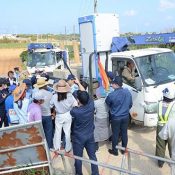
October 8, 2019 Ryukyu Shimpo
On the morning of October 7 the Ministry of Defense started construction on a Ground Self-Defense Force (GSDF) ammunition depot at Bora mine in Gusukube, Miyakojima City, Okinawa.
There was no time between the explanatory meeting and the construction starting.
Early in the morning 10 citizens rushed to protest near the entrance to the construction site, raising their fists and making declarations such as “We will not allow illegal construction,” and “Don’t build a dangerous ammunition depot.”
The citizens engaged in protest activities near the entrance to the construction site starting at 8:00 a.m., and repeatedly called out to the Okinawa Defense Bureau (ODB) personnel to stop construction.
Two vehicles arrived hauling materials to the site, but the citizens blocked their entry and the vehicles were brought to a standstill near the entrance for a long time.
After the deadlock went on for a few hours, at 2:46 p.m. police officers from the Miyakojima Police Station moved the citizens and the two vehicles entered the construction site. No one was injured.
A representative of the citizens group against a missile/ammunition depot that protested at the construction site, Seiei Sunakawa, said with a gloomy countenance: “[This is] the kind of place where local residents even work in the fields, why build a dangerous ammunition depot?”
Sunakawa criticized the explanatory meeting leaving no time before construction commenced, saying, “We cannot allow it,” and “Residents have the right to live and make their livelihoods here.
The State makes light of that.”
A woman in her 70s who was walking in the village nearby hung her shoulders and said, “If I had to say, of course it would be better for there not to be an [ammunition depot] … but there are only elderly people here, and at this point we don’t know if there is anything we can do.”
A man in his 70s who was doing farmwork sighed and said, “It has already been decided. I don’t have anything to say.”
Representative Seihan Nakazato of a Miyakojima citizens’ liaison council against missile bases, who protested the construction starting in the early morning, said, “We absolutely cannot accept constrution of a facility linked to war.”
He touched on the topic of the garrison completed in March in Nobaru Ueno, Miyakojima City, and expressed his anger, saying, “The Ministry of Defense is not listening to citizens’ voices.
It appears to make light of the rights of local citizens and Miyakojima City residents.”
(English translation by T&CT and Erin Jones)
Go To Japanese
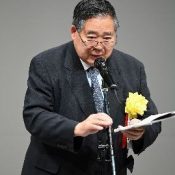
October 6, 2019 Ryukyu Shimpo
The committee to promote the adding of Ryukyu cuisine and Awamori to the UNESCO Intangible Cultural Heritage list (chaired by Masaaki Yasuda) held a rally for Okinawans at Tenbusu Naha on October 5.
The vice-chair of the committee, Tokyo University of Agriculture emeritus professor Takeo Koizumi gave the keynote speech on, “the uniqueness of Ryukyu cuisine and black koji mold Awamori,” and a statement was adopted to promote the two items to the UNESCO Intangible Cultural Heritage list.
In the statement, it presents Ryukyu Cuisine and Ryukyu Awamori as unique food and alcohol that contains ingredients and culture specific to the region and not seen anywhere else in the world.
It also declares that they are intensifying their efforts to inscribe these on the list as they have a duty as Okinawans to safeguard the native food and drink to pass down to future generations.
In his keynote address, Dr. Koizumi explained, “Ryukyu cuisine was born in a subtropical climate, uses pork in many different ways, and was formed with the ideal that diet and medicine share the same principals, and is completely different from Japanese cuisine.
Awamori is a highly original liquor that has 600 years of history, uses a black koji mold native to Okinawa, and a culture-rich aging process known as ‘shitsugi.’”
Additionally, he stressed, “Ryukyu cuisine and Ryukyu Awamori are unparalleled in the world, and are certainly a worthy addition to the UNESCO Intangible Cultural Heritage list.”
Also at the rally were speeches from Okinawa Convention & Visitors Bureau (OCVB) president Yoshiro Shimoji, Okinawa Restaurant Activities and Hygiene Association Chairman Yoichi Suzuki, and some Diet representative elected in Okinawa.
(English translation by T&CT and Sam Grieb)
Go To Japanese
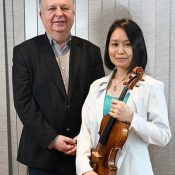
October 8, 2019 Ryukyu Shimpo
Yoko Takaesu
Ryoko Berkes (maiden name Sunagawa), 47, originally from Naha is a violinist who is a part of a Hungarian orchestra.
Classical music is popular in Hungary, which is located in Eastern Europe. According to a representative of the Friends of Canon Club, which is familiar with classical music, it is rare to see a person originally from Okinawa become a member of a European orchestra.
Ryoko arrived in Okinawa with about 80 of the orchestra members from the Győr Philharmonic Orchestra.
On October 19, the orchestra will be having a joint concert at Ryoko’s alma mater, Naha Municipal Matsushima Junior High School. On October 20 from 4 p.m., the orchestra will be performing at the Sawafuji Mirai Hall in Nishihara.
Ryoko started playing the violin around age six. Her mother was a piano teacher, so she spent a lot of time growing up with music since she was young.
She graduated from Matsushima Junior High School and the Music Track of the Department of Art at Okinawa Prefecture Kaiho Senior High School.
After trying for three years, she entered the Musashino Academia Musicae.
In 1996 while she was still attending school, her performance was appraised by a Hungarian violinist.
After graduation, she studied abroad in Hungary where she learned techniques and modes of expression.
She later married the orchestra’s conductor, Kálmán Berkes. She relocated from Japan to the city of Győr in Hungary about seven years ago. She is now an orchestra member of the Győr Philharmonic Orchestra.
Győr Philharmonic prides itself for being 125-years-old.
Ryoko spoke about what it is like to be a part of the orchestra.
She said, “It’s extremely fulfilling to have an opportunity to perform with people who are experienced.”
Relatives and people interested in classical music formed a planning committee, which made her first performance in Okinawa possible.
Three programs, including Antonín Dvořák’s Symphony No. 9 “From the New World” will be performed.
Ryoko looks forward to the performance.
She said, “I was thinking of how wonderful it would be if I could one day perform in my hometown.”
In preparation for the joint concert at Matsushima, Ryoko sends a shout-out to the younger generations who hope to pursue a path in music.
She said, “You’re going to need the perseverance to keep trying until you can do it. Try to ‘be passionate, but calm’ during practice.”
For those interested in purchasing tickets, please call Friends of Canon Club’s Yasuko Arakaki at 090-5733-4071. Tickets can also be purchased at the Shima Piano Center and Fukuhara Musical Instruments.
(English translation by T&CT and Chelsea Ashimine)
Go To Japanese
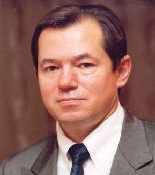
October 7, 2019 Ryukyu Shimpo
Tsuyoshi Arakaki
Sergei Glazyev, a top economic advisor to Russian President Vladimir Putin, gave an exclusive interview to the Ryukyu Shimpo October 6, in which he commented on issues and hopes for Russo-Japanese relations, as well as other topics such as the possibilities for Okinawa.
Glazyev indicated that the northern territories dispute is a, “major impediment” to Russo-Japanese relations, and that, “Modern Japan is an autonomous, independent and powerful nation, and is able to pursue international diplomacy independently for the benefit of their own country.”
He added that escaping from subservience to the U.S. was essential to improving Russo-Japanese relations, and raised the U.S. military bases in Okinawa as a key factor, stating, “[Japan must] shed the legacy of defeat and U.S. occupation that includes the U.S. bases in Okinawa.”
This exclusive interview is the first that Glazyev has given to the Japanese media. He answered the interview request in late September as an advisor to the president.
On October 2, Glazyev was appointed the Minister of Integration and Macroeconomics of the Eurasian Economic Commission (EEC) an economic alliance of five countries that includes Russia and Belarus.
As someone who wields great influence over things such as effective future Russo-Japanese relations, his perception that the U.S. bases in Okinawa as a major impediment could affect future negotiations between Japan and Russia.
During previous negotiations around the northern territories dispute and the Russo-Japanese Peace Treaty, Putin has referred to the details concerning the Japanese issue of the relocation of MCAS Futenma to the Henoko neighborhood in Nago.
Putin indicated, “Construction continues despite the opposition of residents and the governor,” and also noted that the U.S. military was constructing facilities in other regions of Japan, expressing concern over the effect this could have for Russian national security.
Glazyev’s views on the matter seem to be based on the same concerns recognized by Putin.
Glazyev stressed that the political tensions brought about by the northern territories dispute was a, “major impediment” to promoting a cooperative relationship between Japan and Russia.
He indicated that Japan’s diplomatic policy of their claim in the northern territories dispute was born of a seed planted by, “The American GHQ” (the Supreme Commander for the Allied Powers, or SCAP, who administered the occupation of Japan after World War 2), and that “Even now, the U.S. is watching very closely to ensure that the Japanese government does not stray from this course.”
Additionally, he added, “Japan needs to escape the anti-Russian stance created by Washington,” once again touching on the U.S. bases in Okinawa as a symbol of the relationship between the three countries.
Glazyev also praised Okinawa’s potential as a tourism destination due to contributing factors such as being blessed with a great climate and natural environment, state-of-the-art healthcare, and excellent service, stressing, “I have no doubt that by developing some effective advertising, [Okinawa] can become a hotspot for Russian Tourists.”
(English translation by T&CT and Sam Grieb)
Go To Japanese
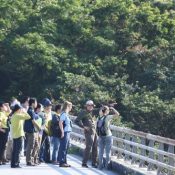
October 7, 2019 Ryukyu Shimpo
Amami-Oshima Island, Tokunoshima Island, the “northern part of Okinawa island” and Iriomote Island was nominated by the Japanese government for the UNESCO World Natural Heritage status.
Experts from UNESCO’s advisory body, the International Union for Conservation of Nature (IUCN) began field evaluations in the nominated sites.
The IUCN inspection conducted on October. 7 was open to the press.
The IUCN mission schedule is as follows: Yanbaru (the “northern part of Okinawan Island”), October. 5-7; Amami-Oshima Island and Tokushima Island, October. 8-10; and Iriomote Island, October. 11-12.
The IUCN is expected to make its recommendations to the World Heritage Committee during the summer of 2020, based on its field reports and assessments of other background materials.
IUCN evaluators previously inspected the four sites in 2017, but due to issues pertaining to the U.S. military’s Northern Training Area adjacent to Yanbaru, the IUCN recommended the World Heritage Committee to defer decisions, and requested fundamental revisions be made to the nomination dossier.
The Japanese government submitted a revised nomination since, making this field evaluation its second time.
On October. 7, IUCN experts Wendy Ann Strahm and Ulrika Åberg surveyed the Yanbaru forest in Kunigami-son from atop the Nagao bridge, which the press was allowed to observe.
Employees of the Environment of Ministry and experts from the World Natural Heritage Proposed Site Scientific Committee offered details of the forest ecosystem to the two evaluators.
The Okinawa Rail (Gallirallus okinawae) and the Okinawa Woodpecker (Sapheopipo noguchii), both of which are designated national natural treasures, could be heard.
(English translation by T&CT and Monica Shingaki)
Go To Japanese
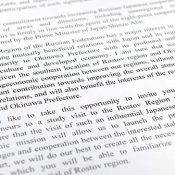
October 7, 2019 Ryukyu Shimpo
Russian government officials and regional mayors are making advances toward Okinawa in the hope of increasing economic exchange with Okinawa.
In regards to his meeting with Governor Denny Tamaki in Saint Petersburg in June, Sergey Glazyev, who was appointed minister at the Eurasian Economic Commission this month, told the Ryukyu Shimpo in late September that he had a very good impression of Governor Tamaki, and expressed his hope to promote economic and personal exchange between the two regions.
The mayor of Rostov, in the southern part of Russia, also sent a personally signed letter to Governor Tamaki.
Rostov deputy mayor Alexey Izotov told the Ryukyu Shimpo that he hopes to see exchange between the town and prefecture eventually leading to a sister relationship, and expressed strong desire for such exchange.
The mayor of Rostov sent a personally addressed letter to Governor Tamaki saying, “[we have] a major interest in establishing and developing mutually beneficial relations with Japan…[starting with] Okinawa Prefecture with its profound and rich history [and] distinctive culture”.
In the letter, he expresses his wish to invite Governor Tamaki to visit Rostov.
Deputy Mayor Izotov expressed strong interest in Okinawa’s tourist industry, particularly medical tourism.
Meanwhile, Okinawa:s Vice Governor Moritake Tomikawa visited Russia from September 3 to 7, participating in the Eastern Economic Forum in Vladivostok, in the easternmost part of Russia, and communicating with a vice mayor of the local government and a director of the local chamber of commerce.
“People in Russia find Japan and Okinawa attractive,” said Vice Governor Tomikawa, emphasizing his positive impression.
“We still don’t have much information about each other, so going forward, I hope to engage in close exchange of information and first and foremost execute a MOU (memorandum regarding cooperation) with Vladivostok and other places in the easternmost region.
If we lay down a strong foundation in places that show promise, we will be able to develop economic exchange.”
Vice Governor Tomikawa said that in his conversations in Vladivostok, there was talk of establishing a direct flight to Okinawa.
“Vladivostok is close, just a little more than three hours by direct flight.
If economic exchange progresses and starts to pay off, I think it is a great idea,” said Vice Governor Tomikawa.
In June, Governor Tamaki participated in the International Economic Forum in Saint Petersburg and also conversed with officials and businesspeople there about tourism inter-regional exchange.
At the Forum, he spoke with Glazyev for around 30 minutes, explaining the attractiveness of Okinawa’s tourism industry and that karate-related exchange between Okinawa and Russia is increasing, and asking for cooperation to achieve further increased exchange with Okinawa.
(English translation by T&CT and Sandi Aritza)
Go To Japanese
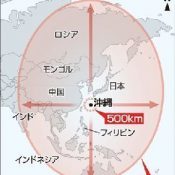
October 3, 2019 Ryukyu Shimpo
Tsuyoshi Arakakai
After withdrawing from the Intermediate-Range Nuclear Forces Treaty (INF Treaty) on August 2, the U.S. announced that it would be deploying a large quantity of intermediate-range ballistic missiles, which were banned under the treaty, to Japan at locations that include Okinawa and Hokkaido.
Ryukyu Shimpo reporting has learned that the U.S. government informed Russia of this through back-door communications.
According to this communication, the U.S. is working with Japan to deploy the missiles starting at the end of 2020, through 2021.
If these missiles are deployed, base capabilities will be further increased, and there are fears that it increases the chances of Japan becoming entangled in a nuclear war. Furthermore, it will rapidly increase the base burden on Okinawa.
An expert with knowledge of U.S. military strategy indicates, “Okinawa has a strong possibility of being a deployment site, due to the large concentration of military bases there.
American media is also pointing to the possibility of deployment to Okinawa.
Military critic Testuo Maeda, who was familiar with the state of the U.S. military after the cancellation of the INF Treaty, indicated that PAC-3 air defense missiles are already deployed to Kadena Air Base, and may be added to or replace the Aegis Ashore ballistic missile defense system that is planned to be deployed to the Araya maneuvering grounds in Akita, and the Mustumi maneuvering grounds in the town of Abu in Hagi, Yamaguchi.
He also noted that making public the frequent visits of nuclear submarines equipped with new missiles to Yokosuka in Kanagawa, Sasebo in Nagasaki, and Uruma’s White Beach is big.
The end of the treaty gave rise to a “new cold war” as the U.S., China, and Russia start to develop new missiles, and the possibility is rising for Okinawa to once again be placed in the precarious state as the frontline, as it was during the original Cold War, when pre-reversion Okinawa hosted a large number of nuclear weapons.
However, due to local resistance and public opinion, it is still unclear if the Japanese government will consent to the deployment.
According to a representative for the Russian president, on August 26 a conference with the theme of a new strategy for Asia was held in Washington after the invalidation of the INF Treaty, and four countries, Japan, Australia, the Philippines, and Vietnam, were raised as possible deployment sites for new missiles.
South Korea is also an ally of the U.S., however it was excluded from the list as denuclearization talks between the U.S. and North Korea continue.
For deployment in Japan, Okinawa, Hokkaido, and mainland Japan were listed as possible locations, and among those it seems inevitable that the U.S. will deploy missiles to Okinawa.
The same Russian representative indicated that with the U.S. decision to increase their military presence in the Asia-Pacific region, there is a great possibility they will reaffirm the importance of the U.S. military bases on Okinawa.
They hypothesize that there may be limited naval conflict between the U.S. and China in the next 2-3 years over things such as the Senkaku and Spratly islands, and as such the U.S. will be giving a lot of attention to the capabilities of the current U.S. bases in Okinawa.
Okinawa is far south of Russia, if missiles are deployed to Japan Russia’s eastern seaboard will be in range, and it is thought that this would wipe away any progress made in the negotiations over the disputed northern territories as well as the execution of a Russo-Japanese peace treaty.
The U.S. has maintained to Russia that their deployment of new missiles is meant to keep China in check, and explained that Russia has no need for concern.
However, Russia has taken this as a new threat, and they have stated that as part of their plans for new defense systems, if the missiles are deployed, “Russian missiles will be pointed in that direction.”
The new missiles being developed by the U.S. are a new tomahawk missile that can be loaded either into a vehicle or submarine, either of which can be equipped with a nuclear warhead. The payload can be anywhere in the 10-50 kiloton range, the lowest power being equal to the nuclear bomb that was dropped on Hiroshima (12 kilotons).
There is doubt that this deployment will be in compliance with Japan’s three non-nuclear principles.
In response to questions from the Ryukyu Shimpo about the existence of a deployment plan, the U.S. State Department referred questions to the U.S. Department of Defense, who after two days has yet to respond to any questions.
(English translation by T&CT and Sam Grieb)
Go To Japanese
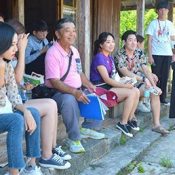
October 3, 2019 Ryukyu Shimpo
“We can become good friends.” A group of 10 Korean college students toured in and outside of Okinawa during their visit to Japan.
The group arrived in Okinawa on September 30 and returned home on October 2.
They visited the Himeyuri Peace Museum in Itoman and the Okinawa Peace Memorial Park.
They also enjoyed staying at a vacation rental in Nanjo.
One group member said, “I really felt that we could become friends by directly interacting with one another,” “The relationship between Japan and South Korea that continues to worsen is at the political or country level.”
The group member felt a deepened mutual understanding.
This cultural exchange was carried out as a result of the Japan-Korea Cultural Federation receiving commission from the Ministry of Foreign Affairs.
It is a part of the Japan-Korea Academic Youth Culture Exchange Program that was drawn up by both the Japanese and South Korean governments.
On October 2 in Nanjo, the group strolled through the Okoku Village in which there are still many traditional houses.
They also went around and viewed Hinpun, a type of entry wall to ward off demons, with scars left from naval guns.
The group deepened their cultural exchange with the local people in a friendly atmosphere.
College senior Sanmyon Lee, 25, said, “I had thought that Japanese people have an enormous hatred toward Korea, but having actually talking with people, that’s not the case.
I now understand the importance of not being influenced by the media and to have direct cultural exchange.”
Yuson Lee, 24, in his first year out of college said, “There wasn’t any point (during our trip) where we were hated for being Korean.
We’re able to become friends through cultural exchange.”
(English translation by T&CT and Chelsea Ashimine)
Go To Japanese
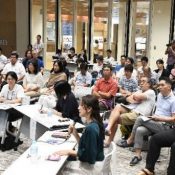
September 29, 2019 Ryukyu Shimpo
“Community Roundtable to Promote SDGs”, a platform to allow island-wide discussions on advancing SDGs (United Nations sustainable development goals), was held on September 28 at the Okinawa Prefectural Library in Naha City.
A group of 80 residents participated in the first-ever community roundtable.
Jun Shimabukuro, chair of the The Bankoku Shinryo Committee (a group commissioned by Gov. Tamaki to advance SDGs) and professor at the University of the Ryukyus, engaged in a lively exchange with experts and participants on how to make Okinawa a leader in fostering a society in which ‘no one is left behind’.
Five other panelists were seated alongside Shimabukuro at the roundtable: Prefectural Planning Department Planning and Coordination Division Manager Hideharu Taira, Onna Village Office Planning Division Chief Kaori Touyama, Ryukyu Shimpo Assistant Managing Director Yoko Shima, Natsuko Shimabukuro from the Ryukyu Asahi Broadcasting news desk, and Keiko Sano, chief representative of JICA Okinawa Office. Mirai Fund Okinawa Vice President Tousei Taira moderated.
An participant pointed out that learning about the existing human rights and coexistence programs helps understand the SDGs better.
Another proposed involving educators and schools by implementing a system in which the prefectural government certifies schools that zealously pursue SDGs.
The discussions from the community roundtable will be further debated in the next Bankoku Shinryo Committee meeting.
During the floor discussion, participant Miwa Nakamura, 51, said: “I would love to see Gov. Tamaki transform Okinawa into a society that leaves no one behind.”
Nakamura’s son has a severe intellectual disability, and was rejected by the vocational high-school of his choice.
Nakamura pointed out, “Nationally, Okinawa has the lowest rate of students who continue on to high school.
Schools are rejecting students despite being under-enrolled; Maybe the students’ school-evaluations and marks were unsatisfactory, or they had an unsavory attitude during the interviews, but these children may have hardships in life, or faced adversities growing up.
Adults should not write off this fact as ‘reaping what you sow’. We need to heed the children’s voices, and incorporate them into Okinawa’s SDGs.”
(English translation by T&CT and Monica Shingaki)
Go To Japanese



















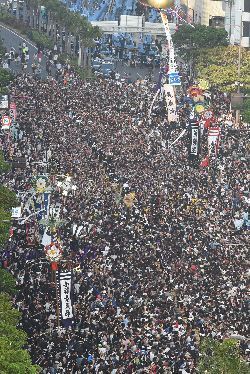









 Webcam(Kokusai Street)
Webcam(Kokusai Street)


